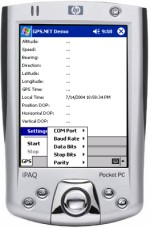Introduction
What is
it that GPS applications need to be good enough to use in a commercial
environment, such as in-car navigation? Also, how does the process of
interpreting GPS data actually work? In this three-part series, I will
cover both topics and give you the skills you need to write a
commercial-grade GPS application that works with a majority of GPS
devices in the industry today.
One Powerful Sentence
This
first part in the series will explore the task of interpreting raw GPS
data. Fortunately, the task is simplified thanks to the National Marine Electronics Association
which introduced a standard for the industry, now in use by a vast
majority of GPS devices. To give developers a head start, I chose to use
some Visual Studio .NET source code from my "GPS.NET Global Positioning
SDK" component. (The code is stripped of features like multithreading
and error handling for brevity.)
NMEA data is sent as comma-delimited "sentences" which contain information based on the first word of the sentence. There are over fifty kinds of sentences, yet an interpreter really only needs to handle a few to get the job done. The most common NMEA sentence of all is the "Recommended Minimum" sentence, which begins with "$GPRMC". Here is an example:
NMEA data is sent as comma-delimited "sentences" which contain information based on the first word of the sentence. There are over fifty kinds of sentences, yet an interpreter really only needs to handle a few to get the job done. The most common NMEA sentence of all is the "Recommended Minimum" sentence, which begins with "$GPRMC". Here is an example:
$GPRMC,040302.663,A,3939.7,N,10506.6,W,0.27,358.86,200804,,*1A
This one
sentence contains nearly everything a GPS application needs: latitude,
longitude, speed, bearing, satellite-derived time, fix status and
magnetic variation.
View post : http://www.c-sharpcorner.com/UploadFile/jperson2000/gps_net08152008190750PM/gps_net.aspx
View post : http://www.c-sharpcorner.com/UploadFile/jperson2000/gps_net08152008190750PM/gps_net.aspx
